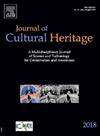An ontology to describe the damage process to built cultural heritage triggered by earthquakes: The CHEDO model
IF 3.5
2区 综合性期刊
0 ARCHAEOLOGY
引用次数: 0
Abstract
Information on cultural heritage is critical both to understand its value and to support management. Collecting, managing, visualizing, and sharing this information requires standardization. In the last decades, architecture has advanced in information management with the implementation of Building Information Modelling (BIM) methodology. The application of this methodology to cultural heritage has associated challenges due to the complexity and heterogeneity of the information. The integration of ontologies and BIM allows obtaining semantically enriched digital models, which has led to a growing interest in the field of architectural cultural heritage. In this article, the Cultural Heritage Earthquake Damage Ontology (CHEDO) model is presented. This ontology has been designed to document damage and loss caused by earthquakes in cultural heritage, through its integration into BIM systems interconnected with databases, although this integration is not addressed in the present work. The CHEDO model integrates terms and relationships to document the damage process in relation to the building characteristics (architectural, spatial, constructional, and geometrical) and the physical environment of the same. This model, by providing a comprehensive description of the building and its environment, allows for complete and accurate documentation of damage, which supports the planning of post-earthquake restoration and reconstruction. To facilitate interoperability with parallel ontologies in close domains of architectural cultural heritage, CHEDO was designed taking as reference the high-level ontology Conceptual Reference Model (CRM) developed by the International Committee for Documentation (CIDOC), of the International Council of Museums (ICOM). The proposed ontology is structured in four blocks: 'building and surrounding environment', to describe the building and its environment; 'building damage', to represent the damage and its causes; 'location', to describe the location of the building and the external processes; and 'terminology', to categorise and classify certain classes of the ontology.
描述地震对建筑文化遗产破坏过程的本体:CHEDO模型
关于文化遗产的信息对于了解其价值和支持管理至关重要。收集、管理、可视化和共享这些信息需要标准化。在过去的几十年里,随着建筑信息模型(BIM)方法的实施,建筑在信息管理方面取得了进步。由于信息的复杂性和异质性,将这种方法应用于文化遗产面临着相关的挑战。本体和BIM的集成允许获得语义丰富的数字模型,这导致了对建筑文化遗产领域日益增长的兴趣。本文提出了文化遗产震害本体(CHEDO)模型。该本体旨在通过将其集成到与数据库相连的BIM系统中,记录地震对文化遗产造成的损害和损失,尽管目前的工作中没有解决这种集成问题。CHEDO模型集成了术语和关系,以记录与建筑物特征(建筑,空间,构造和几何)和物理环境相关的损坏过程。该模型通过提供建筑及其环境的全面描述,可以完整准确地记录损坏情况,从而支持震后恢复和重建的规划。为了促进与建筑文化遗产密切领域的并行本体的互操作性,CHEDO的设计参考了国际博物馆理事会(ICOM)的国际文献委员会(CIDOC)开发的高级本体概念参考模型(CRM)。提出的本体分为四个模块:“建筑和周围环境”,用于描述建筑及其环境;“建筑物损坏”,表示损坏及其原因;“位置”,用来描述建筑的位置和外部流程;术语,用来对本体的某些类别进行分类。
本文章由计算机程序翻译,如有差异,请以英文原文为准。
求助全文
约1分钟内获得全文
求助全文
来源期刊

Journal of Cultural Heritage
综合性期刊-材料科学:综合
CiteScore
6.80
自引率
9.70%
发文量
166
审稿时长
52 days
期刊介绍:
The Journal of Cultural Heritage publishes original papers which comprise previously unpublished data and present innovative methods concerning all aspects of science and technology of cultural heritage as well as interpretation and theoretical issues related to preservation.
 求助内容:
求助内容: 应助结果提醒方式:
应助结果提醒方式:


